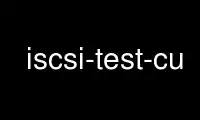
This is the command iscsi-test-cu that can be run in the OnWorks free hosting provider using one of our multiple free online workstations such as Ubuntu Online, Fedora Online, Windows online emulator or MAC OS online emulator
PROGRAM:
NAME
iscsi-test-cu - iSCSI/SCSI test suite
SYNOPSIS
iscsi-test-cu [ OPTIONS ] <ISCSI-PORTAL>
iscsi-test-cu [-i --initiator-name=<IQN>] [-I --initiator-name-2=<IQN>] [-l --list]
[-t --test=<family>|*[.<suite>|*[.<test>|*]]] [-d --dataloss]
[-s --allow-sanitize] [-u --usb] [-V --Verbose-scsi] [-x --xml] [-? --help]
DESCRIPTION
iscsi-test-cu is a test suite for iSCSI/SCSI.
ISCSI PORTAL URL FORMAT
iSCSI portal format is
'iscsi://[<username>[%<password>]@]<host>[:<port>]/<iqn-name>/<lun>'
Port is the TCP port on the target to connect to. Default is 3260.
Username and password are only required if the target requires CHAP authentication.
Optionally you can specify the username and password via the environment variables
LIBISCSI_CHAP_USERNAME and LIBISCSI_CHAP_PASSWORD.
Host can be specified either as a hostname, an IPv4 address or an IPv6 address. Examples:
iscsi://192.0.2.1/iqn.ronnie.test/1
iscsi://[2001:DB8::1]:3261/iqn.ronnie.test/1
iscsi://ronnie%[email protected]/iqn.ronnie.test/1
OPTIONS
-i --initiator-name=<IQN>
All tests use at least one iSCSI connection to the target and this is the initiator
name used for that primary session and it defaults to
'iqn.2007-10.com.github:sahlberg:libiscsi:iscsi-test'
This argument is used to change what initiator name to use for the primary session.
-I --initiator-name-2=<IQN>
Some tests use a second connection to the target, such as the 'it nexus loss tests'.
The default name used for this second connection is
'iqn.2007-10.com.github:sahlberg:libiscsi:iscsi-test-2'
This argument is used to change what initiator name to use for the secondary session.
-l --list
This argument lists all available tests.
The tests are divided up into 'families', 'suites' and 'tests' separated by '.'.
iscsi-test-cu -l
ALL
ALL.CompareAndWrite
ALL.CompareAndWrite.Simple
ALL.CompareAndWrite.Miscompare
ALL.GetLBAStatus
ALL.GetLBAStatus.Simple
ALL.GetLBAStatus.BeyondEol
...
-t --test=<family>|*[.<suite>|*[.<test>|*]]
This argument specifies a comma-separated list of the test expressions to run. If this
argument is omitted then all tests will be executed. You can also just specify a
filename from which to read the list of tests.
To run all tests:
iscsi-test-cu --test=ALL iscsi://192.0.2.1/iqn.ronnie/test/1
To run the READ16 test suite:
iscsi-test-cu --test=SCSI.Read16.* \
iscsi://192.0.2.1/iqn.ronnie/test/1
To just run a single specific test:
iscsi-test-cu --test=iSCSI.iSCSIResiduals.Read10Invalid \
iscsi://192.0.2.1/iqn.ronnie/test/1
Run all tests in the TestUnitReady suite and also the Reaqd16.Flags test
iscsi-test-cu --test=SCSI.TestUnitReady.*,SCSI.Read16.Flags \
iscsi://192.0.2.1/iqn.ronnie/test/1
Run all tests listed in the file ~/tests-to-run
iscsi-test-cu --test=~/tests-to-run
iscsi://192.0.2.1/iqn.ronnie/test/1
-d --dataloss
By default the test tool will only run non-destructive tests. To test commands that
mutates the data, such as the Write* tests you must specify the --dataloss flag.
The tests that requre --dataloss will overwrite the data on the LUN and any and all
data on that LUN will be destroyed when running these tests.
-s --allow-sanitize
The SBC SANITIZE opcode is expected to take significant time before it completes and
thus tests for this opcode are not suitable for normal test runs.
By default any SBC SANITIZE tests will be skipped. Use these arguments if you really
want to perform SANITIZE tests.
-u --usb
SCSI devices that sit behind a USB bus are on linux limited to maximum 120k for any
single SCSI Read*/Write*.
When testing against a USB SCSI device you need to specify these arguments so that the
tests will clamp the read/write size to a maximum of 120k.
-V --Verbose-scsi
The tests aims to be self-documenting. By specifying the -V flag the test tool will
print all SCSI commands that are sent to the device, the arguments and the expected
result.
If a test fails, re-run the failing test with the -V argument to see why it failed. If
that also fails it is time to pull out wireshark and have a look at what happened.
iscsi-test-cu --test SCSI.Read10.BeyondEol iscsi://192.0.2.1/iqn.ronnie.test/1 -V
Suite: Read10
Test: BeyondEol ...
Test READ10 1-256 blocks one block beyond the end
Send READ10 (Expecting LBA_OUT_OF_RANGE) LBA:2097152 blocks:1 rdprotect:0 dpo:0 fua:0 fua_nv:0 group:0
[OK] READ10 returned ILLEGAL_REQUEST/LBA_OUT_OF_RANGE.
...
-x --xml
This option to produce test results in machine readable format for automated testing.
iscsi-test-cu can produce machine-readable test results for consumption by your CI
server. Use the --xml option with any test suite(s), and a file called
CUnitAutomated-Results.xml will be written to your current working directory. These
results can be converted to JUnit format using this script:
http://git.cyrusimap.org/cyrus-imapd/plain/cunit/cunit-to-junit.pl
The return status of the script reflects whether the tests were successful or not. If
you would rather have the script return a status to reflect whether the conversion
from cunit to junit was successful you can patch the script with this:
diff --git a/cunit-to-junit.pl.orig b/cunit-to-junit.pl
index 7cf9320..9182ff0 100644
--- a/cunit-to-junit.pl.orig
+++ b/cunit-to-junit.pl
@@ -226,4 +226,4 @@ foreach my $s (@suites)
}
print "$0: ran $nrun tests, $nfailed failed\n";
-exit(1) if ($nfailed > 0);
+#exit(1) if ($nfailed > 0);
-? --help
Display basic help text.
Use iscsi-test-cu online using onworks.net services
